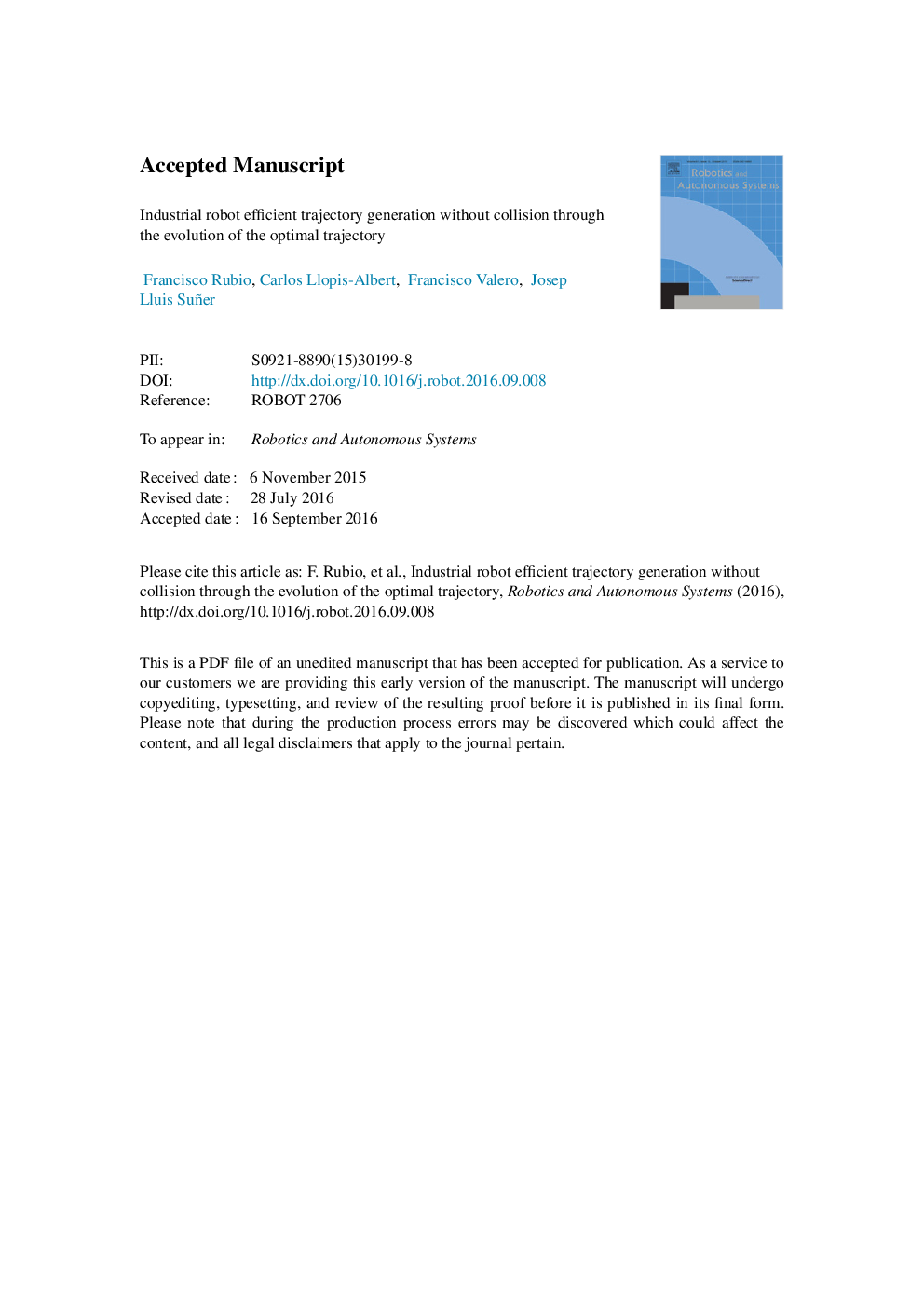| کد مقاله | کد نشریه | سال انتشار | مقاله انگلیسی | نسخه تمام متن |
|---|---|---|---|---|
| 4948913 | 1439856 | 2016 | 15 صفحه PDF | دانلود رایگان |
عنوان انگلیسی مقاله ISI
Industrial robot efficient trajectory generation without collision through the evolution of the optimal trajectory
ترجمه فارسی عنوان
تولید رانندگی کارآمد تولید بدون برخورد از طریق تکامل مسیر بهینه است
دانلود مقاله + سفارش ترجمه
دانلود مقاله ISI انگلیسی
رایگان برای ایرانیان
کلمات کلیدی
دینامیک ربات، بهینه سازی غیر خطی، برنامه ریزی مسیر ربات های صنعتی، روبات های مدل سازی،
ترجمه چکیده
الگوریتم کارآمد برای به دست آوردن مسیرهای روبات های صنعتی در محیط های صنعتی ارائه می شود. این روش با به دست آوردن یک مسیر زمانی مطلوب بدون توجه به حضور موانع شروع می شود. هنگامی که موانع در نظر گرفته می شود، مسیر اولیه (به دست آمده با نادیده گرفتن موانع) امکان پذیر نخواهد بود و باید تکامل یابد تا بتواند یک راه حل باشد. در این مقاله نحوه تکامل آن تا زمانی که یک مسیر جدید بدون امکان برخورد با نقص امکان پذیر است با توجه به موانع ممکن توضیح داده شده است. این یک الگوریتم مستقیم است که در یک فضای گسسته از مسیرها کار می کند، در حال نزدیک شدن به راه حل جهانی به عنوان تفسیر پذیری است. راه حل های به دست آمده مسیرهای کارآیی نزدیک به حداقل زمان اول است و آنها با محدودیت های فیزیکی ربات مواجه می شوند (حداکثر مقادیر گشتاور، قدرت و حرکتی برای هر محرک در نظر گرفته می شود)، اجتناب از برخورد ها، و محدودیت مصرف انرژی . نمونه هایی که قبلا منتشر شده اند و نمونه های جدید در محیط های صنعتی واقعی برای بررسی کار الگوریتم حل شده اند.
موضوعات مرتبط
مهندسی و علوم پایه
مهندسی کامپیوتر
هوش مصنوعی
چکیده انگلیسی
An efficient algorithm is presented to obtain trajectories for industrial robots working in industrial environments. The procedure starts with the obtaining of an optimal time trajectory neglecting the presence of obstacles. When obstacles are considered, the initial trajectory (obtained by neglecting obstacles) will not be feasible and will have to evolve so that it can become a solution. In this paper, the way that it evolves until a new feasible collision-free trajectory is obtained considering the possible obstacles is described. This is a direct algorithm that works in a discrete space of trajectories, approaching the global solution as the discretization is refined. The solutions obtained are efficient trajectories near to the minimum time one and they meet the physical limitations of the robot (the maximum values of torque, power and jerk are considered for each actuator), avoid collisions, and take into account the constraint of energy consumed. Examples already published and new examples in real industrial environments have been solved to verify the working of the algorithm.
ناشر
Database: Elsevier - ScienceDirect (ساینس دایرکت)
Journal: Robotics and Autonomous Systems - Volume 86, December 2016, Pages 106-112
Journal: Robotics and Autonomous Systems - Volume 86, December 2016, Pages 106-112
نویسندگان
Francisco Rubio, Carlos Llopis-Albert, Francisco Valero, Josep Lluis Suñer,
